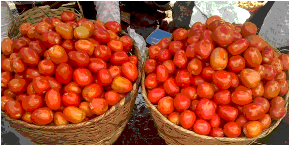By Vivian Deladem
A tomato farmer, Mr Richard Anase, has said that rising transportation costs and unfavourable weather conditions are among the major factors affecting tomato production and pricing in Nigeria.
Mr Anase explained that tomato prices usually increase between April and June due to a decline in supply.
He noted that most of the tomatoes in the country are produced in the northern region between October and April. Once the season ends, supply drops and prices rise as a result of increased demand.
He attributed part of the production challenge to climate change, saying irregular rainfall and flooding have made farming conditions less predictable.
“The weather is no longer reliable. Excessive rainfall leads to flooding, which damages the crops and reduces harvest,” he said.
The farmer also pointed to pest attacks and plant diseases as major problems affecting tomato farming. He listed whiteflies, Tuta absoluta, grasshoppers, and aphids as common pests, while fungal infections were identified as the most frequent disease. To reduce damage, he said chemicals such as pesticides and fungicides are applied once or twice a week.
According to him, although post-harvest losses are generally low, they tend to increase during heavy rains, when tomatoes are more likely to crack and lose market value.
Mr Anase stated that the cost of transporting tomatoes has become a major concern, with drivers charging about ₦1,000 per basket. He added that the pricing of tomatoes is largely determined by demand and supply, and prices rise sharply when supply drops.
He acknowledged that while government support exists for farmers, access to such assistance remains limited due to corruption and poor implementation. He said if the government pays more attention to the sector, tomato farming could become a major source of revenue, potentially more lucrative than crude oil

